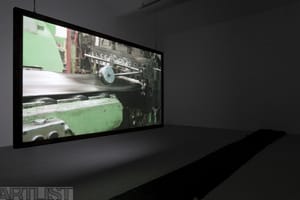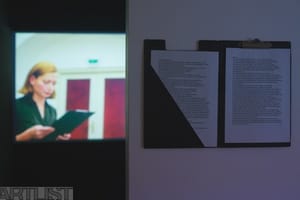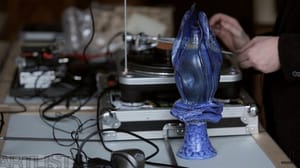- First Name
- Alžběta
- Surname
- Bačíková
- Born
- 1988
- Birth place
- Hodonín
- Place of work
- Praha
- Keywords
- CSU Library
- ↳ Find in the catalogue
About artist
According to Hito Steyerl and Marie Lind, authors of the anthology The Green Room: Reconsidering the Documentary and Contemporary Art (2009), documentary forms always make an appearance in visual art at times of political or social crisis. In their introduction to the book they enumerate such moments: reformist documentary photography of the 1930s, the boom in film essays in the 1970s, and the prevalence of experiments in documentary production at the turn of the millennium. As far as the current situation is concerned, Steyerl and Lind above all observe mistrust on the part of artists regarding the growing privatisation of the mass media and cuts in public grants, and examine their need to question the objectivity of images and information submitted in contemporary new reports or documentary films.
Many years have elapsed since the text by Steyerl and Lind and Documenta 12 (2002), organised by Okwui Enwezor and the flagship of documentary art. And so it is the job of this text to answer the question of how these events still relate to the work of Alžběta Bačíková. How might we revaluate documentary strategy and the different approaches taken to this theme? And how has the world changed since that time?
However, what if we go against the logic of gradual development and deny that there is a need for something like “new documentarism”? What if different forms of documentarisms are combined in contemporary art, from documentary photography via video essays to films that analyse the image and the process of the objectivisation of truth? Given the current Documenta 14, which is taking place as this text is being written, we might say that all of these different approaches intersect and overlap in contemporary art. Traditional documentary films alternate with video essays or photography accompanied by information texts, talking heads enter digitally modified images and vice versa. Documentarism merges with fiction and becomes part of reality.
These days individual approaches do not need to be hierarchised. However, what remains is an interest in the creation of the image itself, an effort to grasp the procedures during which an awareness of concrete events, acts, people and facts emerges. This is precisely the route taken by Alžběta Bačíková. She examines documentary strategies in contemporary art video that form the core of her doctoral research at the Faculty of Fine Arts in Brno, though an interest in this theme can be discerned in even older works. Over the last two years her attention has been caught by the documentary portrait, and it is with the different character of this that the artist experiments in her videos.
The primary instrument by which Bačíková approaches reality remains the camera, to begin with a static device, capturing mainly arranged scenes (or situations involving two or more protagonists), and later mobile and more voyeuristic. There is an accrual of visual plans that dynamise the videos and that the artist forms into a kind of collage. Let us, for instance, compare Talk & Twerk from 2014 with the “documentary” Heroes, which was the central work in her solo exhibition at Gallery Jelení in spring 2017. In the first work a rhetoric teacher encounters a twerk dancer and the camera records how one teaches the other their art. The simple environment of a dance studio does not change during the entire half an hour, but only the way that the actors speak, move and act. Beneath the line that investigates the character of the art of rhetoric or accentuates the erotic physicality of the twerk, another layer appears: the rhetorical training of the viewer gradually persuades us of the absurd political role of the twerk. If we abstract individual types of discourse, we observe the mutual interconnectedness of body and language (word) and how they mutually support each other. The camera records both women statically, and only their position in the space of the dance studio changes.
In contrast, Heroes focuses on one protagonist, Eda, who is introduced to the viewer as a labourer in a tyre factory and as a kung-fu fighter. Here Bačíková uses the camera as a way of following Eda as he goes about his everyday business. It follows his movements, carves out details and blurs the viewer’s focus. The artist again works with the dynamic editing of image and shorts that support each other and intersect. She includes in the video easily recognisable clichés of the documentary form: there is a gradual entrance with a view of a street and instrumental music, which we all know from TV documentaries. And it is these elements, using which the artist formulates her question that returns during the course of the video: by what means is the protagonist’s (film) subjectivity constituted via the form of the documentary film?
Bačíková stipulates a situation – in Heroes she has Eda write a story about a Chinese feminist heroine, in Correspondence (2016) she shoots a man, a gigolo, reading a love letter written in advance – and the protagonists respond to her. The question remains as to what degree we can still speak of documentary video or film. However, this is the essence of the trick being played. Her films are not so much documentary films as films about documentaries.
Another important feature of Bačíková’s work is cooperation, e.g. on events and videos with Barbora Švehláková (Jednou budem dál / We Shall Overcome, 2014, and Dům / Building, 2016) and on exhibitions with Lucie Rosenfeldová and Martina Smutná (Open Call and Vadnoucí vztah / Fading Relationship, both 2016). Aside from their friendship, all these artists are interested in current social themes and the influence of technology, digitalisation, the question of representation and movements that transform our relationships to ourselves and our surroundings. In the video Vadnoucí vztah, which was supplemented at the exhibition Against Nature at Veletržní palác by a textile, abstracted image-construction by Martina Smutná, the three artists came together, and their installation arose within the framework of dialogue, which was later inscribed on the resulting works. The film captures woman in nature and in a detail points to her body and functional sports attire. The tightened technicist textiles act as a metaphor for a desire for perfection and completion that is made impossible by the provocative dialectic of rationality and sensuality. However, the installation produced by the trio Bačíková–Rosenfeldová–Smutná never only works with one theme, but possess multiple plans whose works are always closely interwoven and comprehensive and, like the collage shots in the videos exhibited, communicate together. We follow the different approaches that at any given moment encounter each other in a joint work in which the style of each artist intertwines rather than creating a separate, autonomous whole.
The videos created in collaboration with Barbora Švehláková possess a very specific relationship with music and with a certain musical pop-cultural legacy. The event We Shall Overcome took place in an exhibition at the Gallery Nika and focused on different interpretations of songs with the same title that are known in this country thanks to covers by the Spiritual Quintet. Visitors to the event meet each other in the vestibule of the metro at Palackého náměstí, i.e. where the gallery has its headquarters, and play the songs themselves and discuss them. This is a kind of new interpretation of content that the artists reworked into criticism, as in the case of the video Building, in which Bačíková and Švehláková took the song Líto, je mi líto / I’m Sorry, So Sorry as sung by Hana Zagorová. A tearful song about a lonely women imprisoned in affluence and luxury is transformed and the cover version now becomes an accusation of masculinity present in the masterpieces of architectural modernism (it is easy to recognise Müller’s Villa designed by Adolf Loos and the Villa Tugendhat designed by Mies van der Rohe in the video).
Masculinity and the critical examination thereof is the last of the themes that threads through Bačíková’s entire oeuvre and that is most present in the films made as part of her doctoral research at the Faculty of Fine Arts. All three male protagonists (in the videos Heroes, Doctors and Correspondence) are introduced to the viewer via a text that relates to their character and creates tension between them (and their actual appearance) and between the fiction comprising the film image. However, at the same time the camera follows their own appearance and self-presentation and these shots are placed in the manner of questions before the viewer. This is not explicitly feminist criticism, but more the revelation of particular prism through which we look at reality. And this is another element that is often missing on what we commonly think of as contemporary documentary film.
- Author of the annotation
- Anna Remešová
- Published
- 2017
CV
Studium:
od r. 2015doktorský studijní program na FaVU VUT v Brně
2011–2014
Fakulta výtvarných umění VUT v Brně, Ateliér malířství 2 (Luděk Rathouský a Jiří Franta)
2013
Vysoká škola uměleckoprůmyslová v Praze, Ateliér malby (Jiří Černický a Marek Meduna)
2010–2011
Akademie výtvarných umění v Praze, Škola Grafiky 2 (Vladimír Kokolia)
2007–2009
Fakulta výtvarných umění VUT v Brně Ateliér tělového designu (Jana Preková)
Stáže, tvůrčí pobyty:
2017
Tvůrčí pobyt v ateliéru Egon Schiele Art Centra v Českém Krumlově
Videoarchiv CCA v Tel Avivu s podporou FaVU VUT v Brně
Ocenění:
2018
Finalistka Ceny Jindřicha Chalupeckého a držitelka Divácké ceny Českých center 2018
2014Cena rektora VUT v Brně
Startpoint: Prize for Emerging Artists 2014 – finále soutěže
Exhibitions
- Solo exhibitions
-
2017
Prohnutá dlažba, Galerie mladých, Brno
Průběžná zpráva, Entrance Gallery, Praha
Hrdinové, Galerie Jelení, Praha
2016
Dům, společně s Barborou Švehlákovou, konText, galerie TIC, Brno
Open Call, společně s Lucií Rosenfeldovou a Martinou Smutnou, Galerie UM, Praha
Lékaři, etc. galerie, Praha
2015
Mravní kompromis, Galerie luxfer, Česká Skalice
Etuda o interakci během středně zátěžové situace, společně s Lucií Rosenfeldovou a S.d.Ch., součást akce Grafomani, vypravěči, autoři a producenti, etc. galerie, Praha
Carpe Diem, společně s Martinou Smutnou, Fait Gallery Preview, Brno
2014
Chybný pohyb, společně s Janem Smutným, Galerie Art a Galerie Umakart, Brno
Jednou budem dál, společně s Barborou Švehlákovou, Nika, malá galerie VŠUP, Praha
2013
Hráz, Galerie Tvar, Brno
Věž, Galerie 207, Praha
- Group exhibitions not included in ARTLIST.
-
2017
Ripple Effect, kur. Karina Kottová and Fatoş Üstek, FUTURA, Praha
Vlákna, klubka, tkaniny, kur. Lenka Dolanová, Oblastní galerie Vysočiny v Jihlavě, Jihlava
2016
Against Nature: Mladá česká umělecká scéna, Kur. Edith Jeřábková a Chris Sharp
Národní galerie v Praze, Veletržní palác, Praha
Jazyk, kur. Marek Meduna a Martina Johnová, Galerie Hraničář, Ústí nad Labem
The Offense of Things, kur. Viktor Čech, Galerie Emila Fily, Ústí nad Labem
2015
Jako obraz, kur. Luděk Rathouský, Jiří Franta, Galerie NoD, Praha
Teserakt, GAMU, Praha
Videokemp 2015, Altán Klamovka, Praha
7. Zlínský salon mladých, Krajská galerie výtvarného umění ve Zlíně, Zlín
The Production of Too Many Usefull Things Results in Too Many Useless People, Stúdió Galéria, Budapešť
Zamatový objekt túžby, Galéria Gagarinka, Bratislava
2014
Startpoint: Prize for Emerging Artists 2014, DOX, Praha Diplomanti FaVU 2014, Dům pánů z Kunštátu, Brno
- Collections
-
Sbírka Marek
Fait Gallery
Monography
- Monography
Edith Jeřábková-Chris Sharp (eds.), Against Nature. Mladá česká umělecká scéna, Národní galerie : Praha, 2016.
CENEK, Filip – KLÍMOVÁ, Barbora – ŽÁČKOVÁ, Markéta (eds.). Diplomanti FaVU 2014 / FFA Graduates 2014. 1. vyd. Brno: Vysoké učení technické, Fakulta výtvarných umění, 2014. Nepag. ISBN: 978-80-214-4976-3.
ŠMARDOVÁ, Lucie – ŠVÉDOVÁ, Blanka (eds.), 7. Zlínský salon mladých: společná přehlídka českých a slovenských umělců do třiceti let, Krajská galerie výtvarného umění ve Zlíně: Zlín, 2015.
- Articles
artalk.cz/2018/06/22/alzbeta-bacikova-zajima-me-jak-zaznamenat-skutecnost/, 22. 6. 2018
http://www.filmovyprehled.cz/cs/revue/detail/alzbeta-bacikova-hrdinove, 2. 4. 2017
http://artalk.cz/2014/10/06/letosnimu-startpointu-dominuje-video/, 6. 10. 2014
http://artycok.tv/en/39086/heroes
http://www.filmovyprehled.cz/cs/revue/detail/alzbeta-bacikova-prubezna-zprava
http://artalk.cz/2017/08/11/kdo-je-dnes-textilni-vytvarnik/









